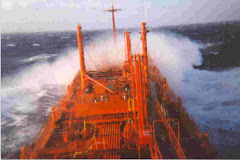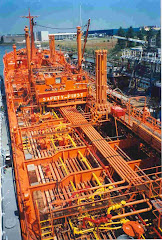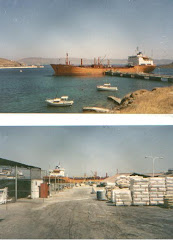The crude oil tanker sector faces the double whammy of excess capacity from overinvestment as well as structural changes in trade flows. It is not a growth industry. Developed economies have proved successful in rolling back consumption and diversifying in alternative fuel sources. Marginal demand growth to fill the slack depends on emerging market economies. The degree of hard landing in China and future level of growth rates in emerging market economies thereafter is very critical in the short and medium term. Those tanker companies heavily dependent on traditional crude oil transport – VLCC’s, Suezmax and Aframax – without other revenue sources are severely exposed. Those with high bank leverage are in severe distress.
Spot market tanker rates can be very volatile. These vessels are dependent on one cargo only: crude oil. Demand is driven by inventory levels; futures pricing, oil production levels and underlying oil import needs. Oil production is in part manipulated by the oil producer cartel OPEC and particularly Saudi Arabia as a swing producer, so productions levels play a key role in available cargo volume for transport. Politics plays a big role with the Iran oil sanctions. Speculation plays a role depending on the future pricing curve whenever it is favorable to buy and store the physical commodity in chartered tonnage for sale at a later date, taking this out of the transport market, leaving less tonnage available for lifting cargos to destination.
As the US has been the greatest consumer of crude oil in cargo volume, the VLCC trades were developed as the most economical means per unit cost to transport crude oil to the Houston area for refining from the Middle East. With the China and emerging market boom of the last decade, there was a deluge of new refinery projects in the Middle East, China and India.
Middle East producers wanted to develop a more value-added economy, investing their profits from oil sales into refineries to produce products at source for export. This led to great optimism in the product and chemical tanker sector that jumped the gun in over investment in these sectors. Since the 2008 global financial crisis, some of these projects have been cancelled, some delayed and some progressed and are on stream. Demand was less than expected for the ship owners.
One of the most novel projects from the Middle East was the Motiva refinery. This is a 50-50 Shell and Aramco joint investment of three new refineries in the US Gulf region. It is the reverse concept of the Middle East refinery projects. They transport crude to the US and refine there. This has been a boon to the product tankers trades in US Jones Act cabotage trade; albeit due project delays and a refinery closure due an accident, it has been slow to come on stream.
Conversely, there have been some overwhelmingly negative structural changes that threaten crude oil trade to the US, namely:
• Technological evolution in the production of tight oil and shale gass, allowing more US domestic energy production, together with the Keystone pipeline project facilitating Canadian oil imports. Whilst this is another potential boost to US Jones Act shipping for distribution of products, it is one of the main contributing factors this year to a dreadful international tanker market.
• Expected increased domestic use of energy resources in the Arabian Gulf, making less crude oil available for export. This is developing on several fronts. First, there is the political front with the Iran oil embargo. Second, there was a drastic reduction of Saudi oil exports during the summer where the oil was diverted to domestic use for electricity production. Finally, the above-mentioned refinery project now coming on stream to produce clean products and chemicals for export. After the GFC, about a third of the projects were cancelled and another third in delay, but the last third is now coming on stream and exporting. This means production at source and less crude oil for export.
The rise of gas shipping as a new growth area is also impacting negatively on crude oil transport. The LNG market is dominated by cargo operators and normally done on long period contracts. Historically, returns have been less than desired and tonnage ordering has overshot the market, but the Japanese tsunami provided the catalyst to rekindle this market to profitable rates with attractive returns to investors. The vessels are much more complex to build than crude oil tankers and capital costs are significantly higher, providing serious entry barriers. The limited number of yards that can turn out such specialized vessels has created a two-year window of opportunity for nice run on rates with existing tonnage in relatively short supply.
Increased LNG production as a long-term secular trend means also downstream enhanced prospects for LPG shipping. Together with the offshore sector, these are presently the major growth sectors in the tanker markets.
Conversely, the crude oil tanker market – except for sudden brief demand spikes in refinery restocking – does not seem to offer good long term growth prospects in the face of these secular trends. A number of established tanker operators like BW Shipping have been shedding VLCC tonnage. BW like Teekay Shipping and major private owners like Angelicoussis in Greece, foreseeing these secular treds have diversified themselves in timely fashion into other more attractive areas like LNG shipping and offshore, positioning their businesses with profits from these new growth areas that shelter them from the current losses on their tanker tonnage.
Some like TeeKay Shipping have sought to develop a franchise in tanker trades demanding special expertise, namely shuttle tankers offloading directly from oil rigs. These vessels have special mooring fixtures and are equipped with dynamic positioning technology. They require specially trained crews. An extension of this offshore business is the FSO and FPSO business with floating oil storage and production facilities, another current growth area in shipping.
Companies who have been slow to adapt to these developments are generally in deep trouble. General Maritime (GMR), for example, just recently got out of Chapter 11. Peter Georgiopoulos appears to have ignored totally all of these developments. His company was probably the weakest of the large listed tanker operators in terms sound commercial management. Perhaps he was distracted by his ventures into dry cargo. Now he has lost control of his tanker business and is fighting to save Genco and Baltic in the current severe bulk carrier markets correction. What Oaktree gained in taking over General Maritime remains to be seen. Presumably they were attracted by a cyclical asset play because the enterprise value of their acquisition is quite low compared to peer tanker operators. Oaktree now seems to be ready to do a startup asset play in dry cargo with Petros Pappas of Oceanbulk. At least this venture promises to have a lower entry and transactions costs than Genmar....
Overseas Shipping Group (OSG) was too little and too late in these structural market developments and left with heavy crude oil spot exposure. It appears to be heading to Chapter 11. Whereas their peer colleague Peter Georgiopoulos by contract proved timely and diligent bringing in Oaktree to support his company, OSG management also appears to be failing with senior lenders in prompt action in debt restructuring. Hopefully, OSG management ultimately will prove adequate to the circumstances. I have always felt that their age and career path has made it very difficult for them to adapt to crisis management. The OSG Board made a good decision to appoint outside advisers.
In these cases, it is not only the over indebtedness of the companies, but also the failure of the business model that put these shipping groups in their present predicament. Conversely, the successful operators like TeeKay Shipping have outperformed peer tanker operators because they adapted in timely fashion their business model to anticipate structural market changes and have much better business models.








